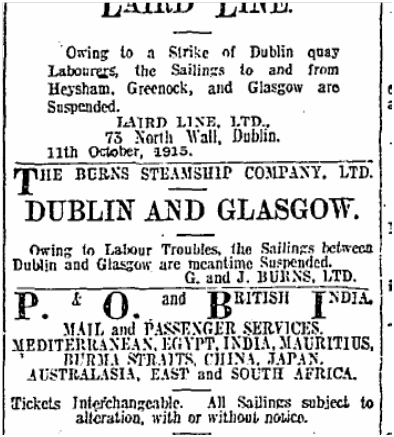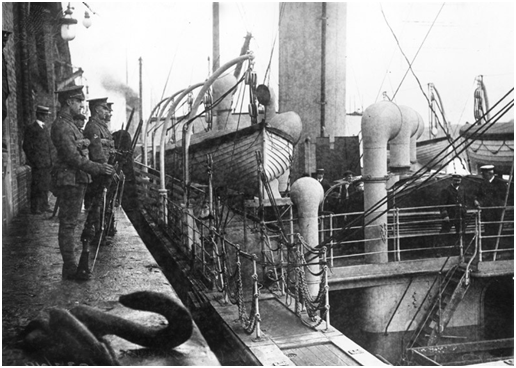________________________________________________________________________________________________________
Remembering 1913
PLEASE NOTE: Next year marks the centenary of the 1913 Lockout. Workers from the Dock-side communities, North and South of the river, were very much to the forefront of the trade union militancy of the time. Members of the East Wall History Group are amongst those that are working together to ensure that the local aspects of this era are properly commemorated. We are anxious to talk to anybody who has any information on this period, most likely through stories passed on from parents or grandparents. If you have anything to contribute, no matter what it is, please get in touch, we would be delighted to talk to you.
_________________________________________________________________________________________________________________________________
October 1915 – The revolutionary dockers in Dublin

In this month in 1915 the “revolutionary dockers in Dublin” were held up as an example by workers abroad. To find out the reason why, read the extract below, which first appeared in The History of the Irish Citizen Army by RM Fox, published in 1943.
_______________________________________________________________________________________
“The way to do peaceful picketing…”
During October of 1915, disputes occurred on the Dublin Docks, due to companies breaking their agreement with the dockers over rates of pay. Connolly wrote in the Workers’ Republic (October 16), that “in view of possible eventualities all the men on strike are undergoing a daily course of military drill.” On November 6, he wrote: “A large section has been formed for drill, and every day the men are instructed in military exercises. We are thus rapidly becoming the best drilled body of men in Ireland. For a time it was difficult to get our men trained, as dock work keeps men employed in the evenings, but the employers are kindly helping us to get over that difficulty. Company after company locks out its men, and then we bring them up to Liberty Hall and take advantage of the opportunity to drill and train them. When each dispute is settled, that squad of men goes back to work and some other squad gets locked out and we get a chance to train them . . . . And when it is over, the men will be back to work on the same rates of pay as their brothers have been conceded. And not a penny less.”
Eventually the docks dispute settled down to a long-drawn-out conflict with the City of Dublin Steam Packet Company. The strikers put on a picket at the North Wall, where clerks in the office were blacklegging on the dockers. The company had invoked the Munitions Act, which contained heavy penalties for strikers. A Nationalist M.P. visited Liberty Hall and threatened the Union with this Act. But the men were unimpressed. They were more perturbed at the way in which the way the police pushed the pickets around outside the shipping office. This seemed a reversion to the worst days of 1913.
Connolly received a report of this and decided that it must be stopped. So he ordered a squad of Citizen Army men to the number of eight or ten to march down the quays, fully equipped with rifles or bayonets, to act as armed pickets. The men obeyed with zest. Outside the offices they halted, formed in double line, and with shining bayonets, carried out their picket duty. Some of the clerks looked through the shed window and saw them marching up the quays. Seized with a guilty panic they bolted. The police then discovered that it was not their place to interfere with Union pickets. After this armed picketing, the dispute was quickly settled.
“It was the first time,” says a Citizen Army man who took part, “that armed workers carried out picket duty in a trade union dispute.”
The news of this event soon spread and John Maclean, the Glasgow revolutionary leader, recommended the Dublin method to workers in Glasgow. “The way to do peaceful picketing,” he cried exultantly at a meeting in the city, “is to march down with Lee Enfield rifles and not a scab on the horizon. Take a line from the revolutionary dockers in Dublin!”
From The History of the Irish Citizen Army RM Fox 1943
___________________________________________________________________________________

Elsewhere in the same book, the importance of the Dock workers in the ranks of the Irish Citizen Army prior to the 1916 rising was referred to. The newspaper excerpt might be a clue to what the author is referring to.
________________________________________________________________________________________
“They worked at awkward hours…”
It must, however, be emphasised here that the Citizen Army – a small force – turned out in practically full strength. Connolly’s own estimate of the numbers of the Citizen Army, given to John Hanratty in March, 1916, when they were both staying in Surrey House, was three hundred armed men. This included the “shot-gun men” – a reserve of dockers who did not parade or drill with the Army, partly because they worked at awkward hours and also because it was thought that they might be more useful at the docks it they were not identified with the general body.
From “The History of the Irish Citizen Army” RM Fox 1943
______________________________________________________________________________________

Troops on duty on North Wall during earlier strike.

